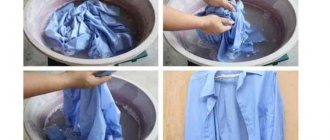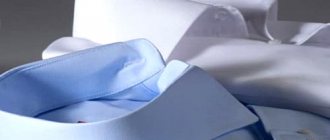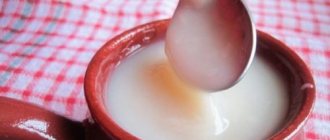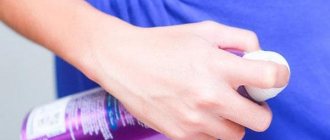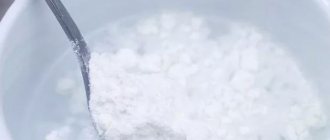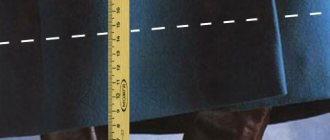For our grandparents, starched things - tablecloths, collars, scarves, cuffs - were the norm of everyday life. But in the modern world this is no longer so popular. Starched items look neat, get dirty less, and are easier to wash. Currently, this method of processing fabric is mainly used by medical workers and professional chefs. There are several tips and recommendations on how to starch a medical cap at home.
Why do you need to starch a medical cap?
It is necessary to starch a medical or chef's cap for several reasons:
- the strictly defined shape lasts for a long time, giving the owner of the headdress a neat appearance;
- impregnation protects the item from contamination, and if it occurs, it is much easier to wash off;
- starch prevents dust from penetrating into the fabric, and with it pathogenic microorganisms.
Ironing starched fabric results in the formation of a thin film on its surface. Airtight protection and serves as a barrier to any contamination. That is why it has long been customary to starch many products. Bed linen and sleepwear were treated with starch, using weak starch for hygienic purposes.
Napkins and tulle were starched to keep them snow-white and ironed. Petticoats were starched to keep their shape. This type of treatment is used to fix lace shoes even today.
Features of working with hats
When working with a chef's or medical worker's hat, you need to take into account the characteristics of hats and professions, otherwise the end result will be far from ideal:
- Chef's hats often differ in height and elongated shape. It is possible to hold such an amount of tissue in the desired position only with the help of the maximum possible fixation. You need to work through the material very carefully; if during the procedure even a small area goes unnoticed, the cap will move and the manipulation will have to start all over again.
- If maximum hardness was used during processing, then there is no need to iron the product. The average degree of processing will only be strengthened by subsequent ironing and the item will take on a more neat appearance.
- Chef's hats of uneven shape (with waves in the upper part) require the preparation of two types of composition, hard for the flat part and medium for the curly part. In this case, first the product is completely immersed in the medium solution and wrung out. Then part of the object is immersed in a strong solution and wrung out again. After which you can begin to give and fix the shape.
- To iron hats, you can only use powerful irons with a steam function, this will avoid the formation of folds and creases in the fabric.
- Today, in addition to traditional starch, special washing powders with a fixing effect, profile fixing sprays, and liquid starch can be used to process hats. The end result and the principle of working with them are approximately the same, but the manipulation time takes much less.
We recommend: What is the best way to clean an army badge and how to do it correctly?
If the cap begins to lose its density and shape, do not simply reprocess it, especially partially. First, the product will have to be washed, otherwise even distribution of the composition will not be achieved. There is no need to worry that the fabric will suffer from such frequent exposure to starch; the natural product does not have any negative effect on the fibers.
How to prepare and what to starch the cap with
Before starching the cap, it should be carefully prepared. Before immersing in the solution, the headdress should be washed and all stains removed. Even the most beautifully shaped cap with stains will not make an impression.
A medical hat that was previously starched releases the fixing compound along with dust when soaked. Stains from a white headdress can be removed using Bleach, hydrogen peroxide or baking soda. Only after achieving ideal cleanliness can you start starching.
Important! It is useless to treat products made of synthetics or containing synthetic threads with starch - there will be no result.
There is a certain set of means with which the cap can be given the desired shape and secured for a long time. Some of them are suitable for medical and chef's hats made of cotton and linen. In order for the headdress not only to keep its shape, but also to shine beautifully, you need to figure out what and how to starch the cap.
Potato starch
The most famous traditional remedy is potato starch. It makes it easy to process natural fabrics, they do not lose their whiteness and retain their shape perfectly.
Note! The degree of hardness of the headgear depends on the concentration of the substance in the solution. The more it is, the stronger the fixation.
Corn and rice starches are also suitable for processing fabrics, but they will not produce snow-white linen. Even potato, if it has a grayish tint, must be washed and dried before use.
PVA glue
Medical and chef's clothing are usually made of cotton. However, there are models that contain synthetics. There is one way to effectively starch a cap using PVA glue. Impregnating a cap with glue is even easier than starch. There is no need to cook anything, you just need to prepare a solution from equal parts of glue and water. Construction glue should be used, as it preserves the natural whiteness of the fabric. Stationery PVA will give the product a yellowish tint.
The headdress is placed in the resulting liquid and the fabric is completely wetted. Usually 15 minutes is enough for this. Then the cap is slightly pressed without twisting, and given the desired shape. In the case of a medical cap, this is done using a jar or saucepan of a suitable diameter.
PVA glue is good because it can fix the shape of any fabric. Even when processing synthetics, the result will be achieved.
Edible gelatin
In many medical institutions, staff clothing is not white, but blue or light green. The shape of products made from colored and synthetic fabrics is often fixed using gelatin. The process technology is as follows:
We recommend:
How to remove cat urine smell from shoes
- take food gelatin at the rate of 3 tablespoons per liter of water;
- dilute it in a small amount of liquid, heating slowly;
- Without bringing it to a boil, remove the container from the heat and add the rest of the water, mix everything thoroughly;
- The product to be treated is immersed in the gelatin solution and allowed to soak completely;
- remove the cap and remove excess liquid by running your hand from top to bottom without twisting;
- The headdress is given the desired shape and left to dry.
Preparatory activities
Before you starch your chef's hat, you need to think about its cleanliness. First of all, the product must be washed and cleaned of all contaminants.
If stubborn stains appear on the fabric, they can be removed using hydrogen peroxide. The composition is simply applied to the item and left in the sun. After the dirt has disappeared, wash the cap as usual.
After this, you can begin starching the product. Which method to choose depends on the shape of the cap.
Classic starching
To starch a medical or chef's cap, make a paste similar to how our grandmothers used to glue wallpaper:
- For soft fixation, take 1 teaspoon of starch per liter of water. The powder is diluted in a small amount of water, the rest of the water is brought to a boil and the solution is slowly poured into it, stirring all the time. If you do everything correctly, the liquid will thicken and become homogeneous. If lumps have formed, the paste can be strained through a sieve.
- Cool the resulting jelly to a warm state and immerse the cap in it for 2-5 minutes, and then remove and express the liquid with your hands.
- The cap soaked in paste is placed to dry on a jar of a suitable size.
- For stronger fixation, the solution is prepared at the rate of 1 tablespoon of powder per liter of water.
- For a medical cap, rigid fixation is more suitable, which is achieved with the ratio: 2 tablespoons of starch per liter of water.
- A medical cap will look better if you add some shine to it. For this purpose, add a teaspoon of borax to the paste.
How to starch a smart chef's hat is a science in itself. It often has a complex shape: cylindrical at the bottom, the cap is topped with folds or folds at the top. To ensure that they are dense but fit well, starching is done with 2 different compositions: the lower part is a hard-fix paste, and the upper part is medium or soft.
Ironing a starched item should be slightly damp. To do this, it is first sprinkled with water and then ironed.
The cap should retain its shape, but folds and dents on it are unacceptable. An iron with a steamer is suitable for processing it, but the steam supply should be minimal.
What to do if there is no starch at home
A simple instruction will answer this question. We warn you right away: the process is labor-intensive! It's easier to buy a pack of starch in the store. But if it so happens that you don’t find starch on sale, make the starch yourself. For this we need 2-3 medium potatoes, a bowl, and a grater.
After pouring water over the planed potatoes, let the solution stand for 2 hours, then drain the top water and add new water, and so on a couple of times. It is better to leave the starch solution overnight and drain the top water in the morning. We get white starch.
Why you can’t fix the cap with sugar
Various types of needlework that require fixing fabric allow the use of sugar for this purpose. However, medical and chef's clothing should not be processed in this way. And it's not about beauty. Sugar attracts various insects, and pathogens are transmitted with them.
If you don’t want to bother with starch or glue, you can purchase a special industrial product. In trade there are both powders with a starching effect and special fixing aerosols.
Rate this post
Basic methods
There are two main ways to starch things. You can give the product elasticity manually or use a washing machine. But the latter method is completely unacceptable for delicate fabrics or items that require partial processing with paste.
Manually
This method is suitable for all products that need to be starched. But to make the task a little easier, you can use the following recommendations.
- Soak. This is a classic procedure. Wet or dry items are soaked for several minutes in a bowl of starch solution. This method is used if you want to manually starch bed linen or other bulky items.
- Application with a brush. You will need a wide paint brush. A starch solution is prepared in a separate container. The slightly damp product is laid out on a fabric surface. Level it carefully. Apply the paste to the surface with a brush, trying to distribute the solution evenly. The product is allowed to dry completely or ironed while wet. This method is applicable for small items (knitted hat, napkin, lace). It is convenient to apply the solution with a brush, treating only individual parts. For example, if you need to starch a shirt collar, flounces, cuffs. Most often, the application method is used for hard starching to provide the shape of a Panama hat or ladies' hat.
- Spraying. You can starch your laundry while ironing. But this method is only suitable for soft solutions. The prepared paste, of low concentration, is poured into the sprayer. The solution is sprayed onto the fabric, which is immediately ironed. This method is suitable for delicate items, such as tulle. You can use a ready-made spray designed for starching laundry during ironing.
In the washing machine
If the manual starching procedure seems like a rather difficult task, then you can entrust the work to a smart assistant. How to starch clothes in a washing machine? It is important to know that if a starch solution is used, then no other rinsing agents are added. The procedure includes the following steps.
- Preparation of the solution. Initially, prepare a paste intended for a soft procedure. You can use ready-made products that allow you to starch products.
- Filling the paste. A starch solution, previously diluted with water, is poured into the compartment intended for the air conditioner.
- Washing procedure. Set the required mode. The final rinse will ensure even distribution of the starch solution. The linen is taken out, shaken and hung, carefully straightening out all the folds. After starching, the washing machine must be wiped with a damp cloth and then wiped dry.
Preparing clothes for the procedure
Before starching the medical cap and uniform, the clothes must be washed, rinsed, and removed from stains. If bleach does not remove stains, you can remove them with ordinary household products.
Peroxide
Hydrogen peroxide removes even the most stubborn formations. To do this, just apply a little liquid to the stain and leave the clothes in the sun. When the dirt disappears, simply treat the cleaned area with water.
Soda and vinegar
Another effective method that copes with even the most stubborn dirt. To do this you need:
- pour baking soda onto the stain;
- pour 9% vinegar on top;
- leave overnight;
- Wash in the morning with clean water.
Starch or buy a ready-made fixative solution: reviews
Starch for clothes is already a thing of the past. Nowadays, any hardware store sells a special starch product. A large bottle (like hairspray, only bigger). When you iron your clothes, you spray this product on it. It's simple!
Amorka, https://www.woman.ru/home/medley9/thread/3906531/
My grandmother made very sweet water (with sugar). Keep your products in this solution and dry them in the shape you need. all is ready. There should be sugar crystals left on the threads. Good luck.
Nadezhda, https://www.woman.ru/home/medley9/thread/3906531/
As a child, I remember my grandmother starched tulle curtains after washing and stretched them onto a large hoop. And the bed linen, remember, almost everything was white and even with embroidery and lace... it was starched to make it easier to wash later (starch did not allow the linen to get dirty so much - smooth surface), but now there is no need for this - everything is simplified for life and many do not iron bed linen and towels at all.
Laguna, https://lady.mail.ru/forum/topic/vy_krahmalite_bele/?page=3#topic-form
I don't use starch for everything, but there are some things that call for it. I remember I had to starch the hare’s ears for a matinee. So I put the hat with ears only in a thick mixture of starch. They really stood like a bell!
Anonymous, https://sovet.kidstaff.com.ua/question-9082
woman365.ru

